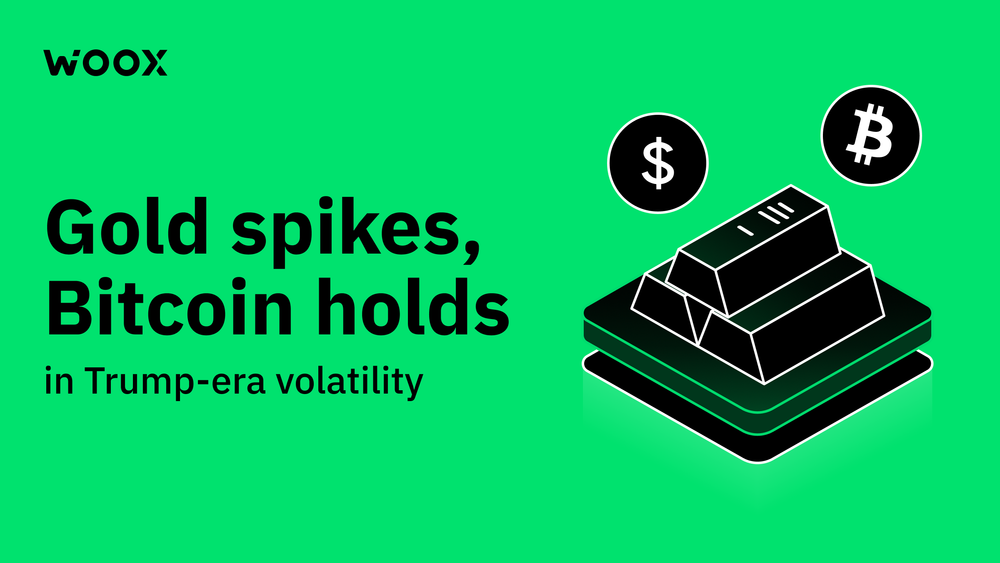Gold spikes, Bitcoin holds in Trump-era volatility
By Pat Zhang, head of Research, WOO X
Bitcoin is starting to take on characteristics of a macro hedge asset. Recent price action, institutional adoption, and shifting investor behavior suggest that Bitcoin may be evolving into a complement to gold rather than a speculative outlier. Although it still behaves differently from gold in some market conditions, data shows Bitcoin is increasingly treated as a store of value during macro shifts.
TLDR
- Bitcoin has historically amplified the movements of the S&P 500 but is now showing signs of decoupling.
- Correlation between Bitcoin and equities reached its most negative level on record in 2024.
- Institutional interest in Bitcoin is growing, but allocation still lags far behind gold.
- Bitcoin and gold respond differently to market stress and monetary policy.
- Rather than replacing gold, Bitcoin appears to be emerging as a digital complement.
In April 2025, Donald Trump’s sweeping tariff policies triggered a wave of volatility across global markets. His reciprocal tariffs set a 10% baseline on imports, with much steeper rates for China, the EU, and Taiwan. Within days, the S&P 500 shed $5.8 trillion in value, its worst single-week drop since the 1950s.
As markets plunged, gold hit an all-time high of $3,383. Bitcoin, while volatile, remained afloat between $80,000 and $90,000, hinting at a potential shift in its role during macro stress. With the Fed holding rates steady despite recession concerns, a new hedge playbook may be forming, and this time, it could be on chain.
Bitcoin mirrors stocks, but with higher volatility
To be sure, Bitcoin’s price trends have closely tracked the S&P 500, but with greater magnitude in both directions, and according to a Nasdaq analyst:
- In 2024, the S&P 500 rose 24 percent while Bitcoin gained 135 percent.
- In 2023, the S&P climbed 26 percent and Bitcoin surged 147 percent.
- In 2022, the S&P declined 19 percent, and Bitcoin dropped 65 percent.
This pattern reinforces the view that Bitcoin has acted as a high-beta play on broader market sentiment. It moves with risk assets but reacts more aggressively.
Above: Bitcoin’s correlation with traditional risk assets is no longer consistent. In July 2024, the 30-day rolling correlation between Bitcoin and the S&P 500 dropped to negative 0.87, the lowest level ever recorded. This shift implies that Bitcoin may be breaking away from its previous pattern of tracking tech stocks and equity indices.
Decoupling, where the correlation moves closer to zero or turns negative, is especially noticeable during moments of heightened macro uncertainty or when crypto-native capital flows dominate. While one month of divergence does not confirm a structural shift, it is an important signal that Bitcoin is beginning to follow its path.
Institutional investors are watching, but allocation remains low
Public companies and off-market institutions are quietly increasing their Bitcoin holdings. The launch of spot Bitcoin ETFs has made access easier for a broader group of investors. However, Bitcoin’s market cap is still approximately 1.7 trillion dollars, compared to gold’s 21 trillion dollars. Most investment advisors still allocate little to no exposure to Bitcoin.
This suggests that Bitcoin is not yet treated as a core hedge asset. Instead, it remains in a transitional phase, where institutional demand is rising but has not yet reached critical mass.
Political risk drives demand for hard assets
On April 21, gold surged to an intraday all-time high of $3,383 per ounce after reports that Donald Trump had threatened to fire Federal Reserve Chair Jerome Powell. This raised immediate concerns over the independence of the central bank. If Powell were removed before the end of his term, it would signal potential instability in US monetary policy and increase the likelihood of a decline in the dollar, US equities, and Treasury bonds.
In response, market participants turned to gold, the traditional safe-haven. Bitcoin also posted a strong performance during this period. This reaction highlights Bitcoin’s growing role as a complementary hedge in times of political and monetary uncertainty. While gold remains the first choice for institutional hedging, Bitcoin is increasingly viewed as a parallel store of value by a new class of investors.
New risk-transfer mechanism
As of April 21st, BTC has continued to register new local highs in tandem with gold, with prices reaching $88,814 and $3,484, respectively. In recent weeks, a clear risk-transfer mechanism has emerged: in the absence of positive macro catalysts, US equities trend lower, often dragging BTC with them, albeit with less downside volatility. However, when risk-off flows dominate, triggered by USD weakness, rising policy uncertainty, or geopolitical escalation, gold and gold-backed instruments experience strong inflows. These flows often spill over into BTC, reflecting a market structure where crypto-native and macro-driven capital interact. This feedback loop reinforces BTC’s evolving role as a high-beta, liquidity-sensitive hedge asset that complements traditional inflation hedges.
Bitcoin responds differently to liquidity shocks
Despite its similarities to gold, Bitcoin still behaves more like a risk asset when markets face stress. Its price is more heavily influenced by liquidity and investor sentiment. In periods of tightening financial conditions, some investors sell Bitcoin to cover other positions or reduce risk, unlike gold, which often benefits directly from increased fear. At the same time, Bitcoin tends to react more strongly to shifts in monetary policy. If the Federal Reserve pivots from a hawkish to a dovish stance, Bitcoin can rally sharply due to its sensitivity to liquidity. Gold also benefits from easing, but its price may be influenced by geopolitical dynamics and long-term inflation expectations rather than short-term flows.
Digital gold, but not a full replacement
Bitcoin and gold share key features, including scarcity, decentralization, and rising demand from institutional and sovereign entities. However, they are fundamentally different assets. Gold has thousands of years of historical acceptance, industrial utility, and legal clarity across jurisdictions. Bitcoin is still a young asset class, with a shorter track record and ongoing regulatory debate. In inflationary environments, both gold and Bitcoin can perform well. Over the past decade, Bitcoin has often led all asset classes in annual returns. It has also experienced sharper drawdowns, making it less stable as a store of value compared to gold.
Bitcoin is not replacing gold as the world’s core hedge asset, but it is carving out a credible role alongside it. Increased institutional adoption, ETF accessibility, and investor behavior during political shocks all point to a shift in how Bitcoin is perceived. For now, Bitcoin should be seen as a high-volatility complement to gold. The two assets serve different investor needs, and their coexistence may become the new normal in portfolios seeking to hedge against monetary risk and geopolitical instability.
Disclaimer
The information provided in this article is for general informational purposes only and does not constitute financial, investment, legal, or professional advice of any kind. While we have made every effort to ensure that the information contained herein is accurate and up-to-date, we make no guarantees as to its completeness or accuracy. The content is based on information available during writing and may be subject to change.
Please note that this article includes references to third-party websites and data provided solely for convenience and informational purposes. We do not endorse or assume any responsibility for the content, accuracy, or reliability of any information, products, or services offered by third parties.
Cryptocurrencies involve significant risk and are NOT suitable for the majority of investors. The value of digital currencies can be extremely volatile, and you should carefully consider your investment objectives, level of experience, and risk appetite before participating in any staking or investment activities.
We strongly recommend that you seek independent advice from a qualified professional before making any investment or financial decisions related to cryptocurrencies. We shall in NO case be liable for any loss or damage arising directly or indirectly from the use of or reliance on the information contained in this article.


